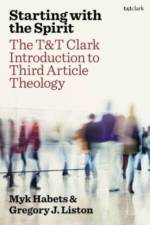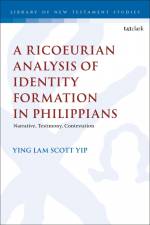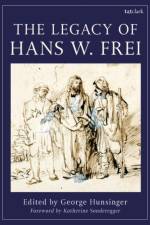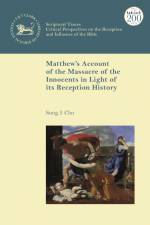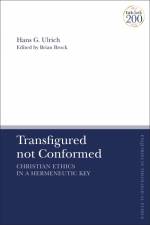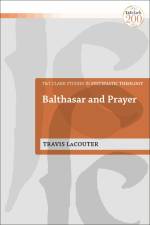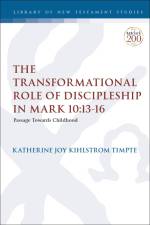Bøger udgivet af T & T CLARK US
-
- Bog
- 249,95 kr.
-
1.167,95 kr. Scott Ying Lam Yip presents the first specialized narrative study devoted to the identity formation processes in Philippians, based on Paul Ricoeur's narrative theory. Yip demonstrates that the "Christian identity" of the Philippian community is shaped amidst competing narratives with divergent comprehensions, and suggests that it is within an intra-Jewish contestation of testimonies that Paul updates his understanding of God and contends with a group of Jewish Christian leaders regarding the meaning of his suffering.Yip argues that Paul faces a double contestation of narrative in which both the political authorities and a group of Jewish Christian leaders see his imprisonment as futile and unnecessary; alerting him to an emerging crisis in which the Philippian community's conviction in suffering with him has begun to decline. It is thus essential for Paul to synthesise and install a new paradigmatic story of Christ so that his suffering can be discerned as the defining mark of God's renewed manifestation in an era of Christ's eschatological Lordship. Yip explores the means by which Paul - in a contestation of authority for the re-appropriation of God's past work - contrasts the future-oriented temporality of his testimony with the past-oriented one of the Jewish Christian leaders. He concludes that Paul affirms the value of his present suffering in truthfulness and installs his testimony to be the exemplary story for the Philippian community.
- Bog
- 1.167,95 kr.
-
1.167,95 kr. Joel M. Rothman considers the significance of cosmology in biblical and extra-biblical texts, and the role of the cosmic journey in many apocalyptic narratives. He posits that Revelation's narrative likewise takes the hearer on a virtual journey, through a cosmic story-space of great theological significance. While scholarship commonly assumes a three-tiered cosmos in Revelation, Rothman argues that Revelation's narrative operates in a four-tiered cosmos, with the hyper-heaven sitting above the sky-heaven, earth, and abyssal depths; a cosmic story-space that is recreated in the imagination of the hearers.Beginning with a methodology of visual narrative reading, Rothman then discusses the assumptions and existing conceptions regarding heaven and earth. He stresses that Revelation does not exhibit tension in its portrayal of heaven - between heaven as a site of conflict and heaven as the realm in which God truly reigns - but rather shows readers a sky-heaven characterised by archetypal conflict between powerful sky-beings and a hyper-heaven defined by full recognition of the Throne. In journeying through the sky-structure and God-space and by analysing the four cosmic layers in operation, the distinct nature of the two sky-spaces, cosmic change and the ideological import of the cosmic structure, Rothman demonstrates that the existence of the hyper-heaven - in contradistinction with the limited lived-cosmos of earth and sky-heaven - is a present guarantee of the final cosmic transformation that creates a new space for human life, exclusive of imperial draconian elements.
- Bog
- 1.167,95 kr.
-
1.167,95 kr. Considering the importance of pneumatological themes for interpreting Paul's argument of Galatians, Grant Buchanan explores how Paul draws from Jewish traditions of creation and the Spirit and presents a fresh cosmogony to the Galatian church. He suggests that Galatians outlines an epistemological shift in how Paul sees past, present, and future reality in light of Christ and the presence of the Spirit in the lives of the believers. The most crucial aspect of this new cosmogony is the centrality of the Spirit in Paul's argument in Galatians 3:1-6:17, with Buchanan's exegesis revealing that the Spirit, the Galatians' identity as children of God and the new creation motif are not merely elements of Paul's argument but intrinsic to it.Buchanan demonstrates that Paul renders Jewish and Gentile identities no longer valid, instead revealing that God's favour and election is already with them by stating that those who have the promised Spirit are all children of God. He examines Jewish biblical and Second Temple extra-biblical texts that explicitly connect the Spirit to creation themes, including Genesis, Ezekiel, the Dead Sea Scrolls and the Wisdom of Solomon. Taking Galatians 6:11-17 as the body-closing of the letter, the new creation motif directly implies the activity of the Spirit in the creation of Christian identity. Analysing 6:15 from this pneumatological perspective, Buchanan argues that the new creation motif represents a key aspect of Paul's generative cosmogony and pneumatology, indicating a far broader socio-cosmic transformation than previously assumed, and it becomes a key to understanding Paul's argument.
- Bog
- 1.167,95 kr.
-
1.167,95 kr. Friendship and other intimate (but not always amicable) relationships have received some attention in the greater field of research on early Judaism and Christianity, though not as much as deserved. This volume celebrates and builds upon the life-long work of Adele Reinhartz, covering the various permutations of relationships that can be found in the Gospel of John, the wider corpus of early Jewish and Christian literature, and cinematic re-imaginings thereof.While the issue of whether one can 'befriend' the Fourth Gospel in light of the book's legacy of antisemitism is central to many of the essays in this volume, others address other more or less likely friendships: Pilate, Paul, Lazarus, Judas, or Mary Magdalene. Likewise, the bonds between ancient texts and contemporary retellings of their stories feature prominently, with contributors asking what kinds of relationships filmmakers encourage their audiences to have with their subjects. This volume explores some of the rich variety of relationships in the ancient world, and unpacks the intricate and dynamic processes and interactions by which human relationships and societies are generated, maintained, and dissolved.
- Bog
- 1.167,95 kr.
-
396,95 kr. The contributors provide fresh insight into the context surrounding the composition and reception of the Psalms, the relationships between the Psalms, and of early audiences who engaged with the material. Close attention is also paid to specific interpretative problems which emerge in the Psalms, both linguistic and theological. Consequently, there is the creation of a more sophisticated historical reconstruction of how the Psalms were used originally and in subsequent periods, opening up challenges and possibilities for scholars through emphasizing the need in critical Psalms scholarship for vitality and imagination.
- Bog
- 396,95 kr.
-
398,95 kr. Thomas Goodwin has been described as 'the forgotten man of English theology' and, though known by some as a pioneer of congregationalism and a prominent member of the Westminster Assembly, the true significance and scope of his life's work has only recently been discovered. Historical reassessment has uncovered that the majority of Goodwin's treatises were intended to form a grand project defending Reformed soteriology in the 1650s against new threats as well as traditional opponents. Examining Goodwin's notion of union with Christ in relation to mystical indwelling, transformation, justification and participation, this study demonstrates the central role of union with Christ in Goodwin's soteriology. The application of salvation, he contended, must be founded on 'real' union with Christ (i.e., mystical union forged by Christ's indwelling) in order to advance a trinitarian, federal, high Reformed soteriology in which redemption from sin is set within a Reformed scheme of Christocentric deification. This in-depth analysis makes a fresh contribution to recent controversy over union with Christ in the post-Reformation period.
- Bog
- 398,95 kr.
-
396,95 kr. Jonathan B. Ensor revisits the scholarly consensus concerning Paul's intermediate visit to the Corinthians between his first and second epistles. Ensor re-evaluates the textual evidence, interpreting the event through a socio-historical lens that focuses upon ancient trial by ordeal and exit in the context of communal conflict, shedding significant light upon the social behaviours involved in this event and its interpretation.Beginning with a review of relational and social-spacial dynamics and sources of conflict, Ensor then explores the politics of displacement in Graeco-Roman antiquity to analyse the relational contours of Paul's intermediate visit to Corinth. From these insights, Ensor interprets Paul's autobiographical narrations of apostolic ordeal and Paul's announcement of imminent return to Corinth in 2 Corinthians. Ensor concludes that Paul, through the ordeal accounts, aimed both to reverse the judgments against him emerging from the intermediate visit, and to undermine the evaluative structure of his detractors who viewed him as impotent, illegitimate, and displaced.
- Bog
- 396,95 kr.
-
1.167,95 kr. - Bog
- 1.167,95 kr.
-
396,95 kr. - Bog
- 396,95 kr.
-
396,95 kr. - Bog
- 396,95 kr.
-
396,95 kr. This pioneering study of Christian sun symbolism describes how biblical light motifs were taken up with energy in the early Church. Kevin Duffy argues that, living in a world of 24/7 illumination, we need to reconnect with the sun and its light to appreciate the meaning of light in the Bible and Christian tradition. With such a retrieval we can appreciate Pope Francis's insistence that, like the moon, the Church does not shine with its own light, and assess the claim that the Eucharist is to be celebrated 'Ad Orientem', that is towards the rising sun in the East. Liturgy, architecture, poetry and the writings of saints and theologians such as Augustine, Hildegard of Bingen, Francis of Assisi, and Thomas Traherne offer abundant resources for a much needed ressourcement. While Christ was preached as the True Sun among sun-worshipping Aztecs, and the consecrated host was placed in a solar monstrance on Baroque altars, in the modern era solar themes have been neglected. In this accessible work, the author suggests that we rebalance a spiritual symbolism that has over-emphasised darkness and cloud at the expense of light and sun. He proposes a creative retrieval of the traditional title of Christ as the Sun of Justice. This title blends the personal, the social and the cosmic/ecological, and speaks powerfully to a secularising era that contemporaries Friedrich Nietzsche and Thérèse of Lisieux both described as one where the sun does not shine.
- Bog
- 396,95 kr.
-
1.169,95 kr. - Bog
- 1.169,95 kr.
-
1.167,95 kr. - Bog
- 1.167,95 kr.
-
1.167,95 kr. Based on case studies, the book creates a multidisciplinary conversation on the gendered vulnerabilities resulting from extractive industries and toxic pollution, and also charts the resilience and courage of women as they resist polluting industries, fight for clean water and seek to protect the land. While ecumenical in scope, the book takes its departure from the concept of integral ecology introduced in Pope Francis' encyclical Laudato Si'. The first three sections of the book focus on the social and ecological challenges facing minoritized women and their communities that are related to mining, pollutants and biodiversity loss, and toxicity. The final section of the book focuses on the possibilities and obstacles to global solidarity. All chapters offer a cross disciplinary response to a particular local situation, tracing the ways ecological destruction, resulting from extraction and toxic contamination, affects the lives of women and their communities. The book pays careful attention to the political, economic, and legal structures facilitating these life-threatening challenges. Each section concludes with a response from a 'practitioner' in the field, representing an ecclesial organization or NGO focused on eco-justice advocacy in the global South, or minority communities in the global North.
- Bog
- 1.167,95 kr.
-
1.787,95 kr. - Bog
- 1.787,95 kr.
-
1.167,95 kr. This is a new interpretation of Dostoevsky's novel The Brothers Karamazov that scrutinizes it as a performative event (the "polyphony" of the novel) revealing its religious, philosophical, and social meanings through the interplay of mentalités or worldviews that constitute an aesthetic whole. This way of discerning the novel's social vision of sobornost' (a unity between harmony and freedom), its vision of hope, and its more subtle sacramental presuppositions, raises Tilley's interpretation beyond the standard "theology and literature" treatments of the novel and interpretations that treat the novel as providing solutions to philosophical problems.Tilley develops Bakhtin's thoughtful analysis of the polyphony of the novel using communication theory and readers/hearer response criticism, and by using Bakhtin's operatic image of polyphony to show the error of taking "faith vs. reason", argues that at the end of the novel, the characters learned to carry on, in a quiet shared commitment to memory and hope.
- Bog
- 1.167,95 kr.
-
396,95 kr. Nathanael Vette proposes that the Gospel of Mark, like other narrative works in the Second Temple period, uses the Jewish scriptures as a model to compose episodes and tell a new story. Vette compares Mark's use of scripture with roughly contemporary works like Pseudo-Philo, the Genesis Apocryphon, 1 Maccabees, Judith, and the Testament of Abraham; diverse texts which, combined, support the existence of shared compositional techniques. This volume identifies five scripturalized narratives in the Gospel: Jesus' forty-day sojourn in the wilderness and call of the disciples; the feeding of the multitudes; the execution of John the Baptist; and the Crucifixion of Jesus. This fresh understanding of how the Jewish scriptures were used to compose new narratives across diverse genres in the Second Temple period holds important lessons for how scholars read the Gospel of Mark. Instead of treating scriptural allusions and echoes as keys which unlock the hidden meaning of the Gospel, Vette argues that Mark often uses the Jewish scriptures simply for their ability to tell a story.
- Bog
- 396,95 kr.
-
548,95 kr. This volume presents, in published form, the detailed commentary work of E. Earle Ellis on Paul's first letter to the Corinthians. At the time of his death Ellis had been working for many years on a volume for the International Critical Commentary on the epistle. Because Ellis was unable to complete the volume before his passing and had left instructions that it should not be completed, Terry Wilder instead presents Ellis' profound exegetical insights in the form of his completed commentary sections on 1 Corinthians, with minimal editorial intervention.In addition to collating Ellis' detailed critical commentary on 1 Corinthians chapters 1-13, with edited notes on chapter 14, Wilder has also completed an original editorial essay that provides a synthesis of Ellis' notes and thinking on chapters 15 and 16. Closely assessing the letter's address, salutation and thanksgiving and Paul's words on true and false wisdom, sexual relationships, liberty's boundaries and the regulation of church services, Ellis' final work is a crucial resource for a core New Testament text.
- Bog
- 548,95 kr.
-
396,95 kr. Vita Daphna Arbel uses critical theories of gender to offer an alternative reading of the multilayered conceptualization of the Song of Song's feminine protagonist: "the most beautiful woman". Arbel treats "the most beautiful woman" as a culturally constructed and performed representation of "woman," and situates this representation within the cultural-discursive contexts in which the Song partly emerged. She examines the gender norms and cultural ideologies it both reflects and constructs, and considers the manner in which this complex representation disrupts rigid, ahistorical notions of femininity, and how it consequently indirectly characterizes "womanhood" as dynamic and diverse.Finally, Arbel examines the reception and impact of these ideas on later conceptualizations of the Song of Songs' female protagonist with a heuristic examination of Mark Chagall's Song of Songs painting cycle, Le Cantique des Cantiques. These compositions-selected for their diverse depictions of the Song's protagonist, their impact on European art, and their vast popularity and bearing in the broader cultural imagination-illustrate a fascinating dialogue between the present and the past about the "most beautiful woman" and about multiple femininities.
- Bog
- 396,95 kr.
-
365,95 kr. Sung Cho addresses the seeming contradiction of Herod the Great's massacre in Matthew 2:16-18, questioning why such a tragedy had to occur, why it was included in the good news of Jesus, and what connection it has to ancient prophecies. In creating a reception history of the Massacre of the Innocents, Cho progresses through two millennia worth of interpretation and depiction to highlight key works for discussion. Beginning with a close reading of Matthew 2:16-18, Cho moves to analyse depictions of the tragedy in the Early Patristic Tradition, from the sixth century to the early modern period, and thus to the present day; complete with an examination of visual interpretations of the massacre. Cho's examination provides a positive step to understanding the depths of human suffering with the help of many diverse perspectives.
- Bog
- 365,95 kr.
-
- Bog
- 396,95 kr.
-
548,95 kr. - Bog
- 548,95 kr.
-
396,95 kr. - Bog
- 396,95 kr.
-
396,95 kr. - Bog
- 396,95 kr.
-
396,95 kr. - Bog
- 396,95 kr.
-
396,95 kr. - Bog
- 396,95 kr.
-
- Bog
- 398,95 kr.
-
548,95 kr. - Bog
- 548,95 kr.
-
258,95 kr. If we wish to understand ourselves and the world in relation to God, what contribution to our understanding should we expect from a Christian tradition with its roots in the Bible, and what should we expect from the natural sciences?Neil Messer sets out five types of answer to that question. The responses range from the view that the Christian tradition has nothing to contribute, through various forms of dialogue, to the claim that science is irrelevant to theological understanding. This classification scheme is illustrated and tested by extended explorations of three topics in the science and theology field: how to think about God's action in the world, how to make theological sense of the suffering and destruction involved in the evolution of life, and how theology should respond to the scientific study of religion. The classification offers a way to understand and evaluate these debates, and the discussion of specific examples demonstrates the strengths and weaknesses of each type of approach.The book concludes with suggestions for how readers might use this scheme to guide their own work on science and theology. For students and researchers in science and theology, this book offers three things: a tool for understanding specific debates in science and theology, critical surveys of some of the most important debates in the field, and a concise guide to ways of setting up encounters of theology with science.
- Bog
- 258,95 kr.

